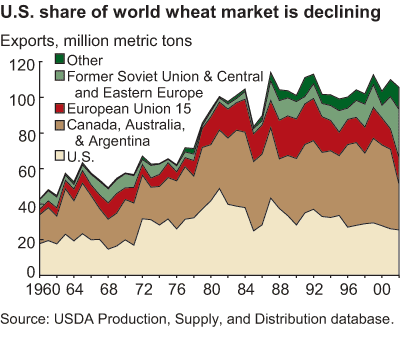Nontraditional Exporters Increase Role In Wheat Market
- by Edward Allen and Ronald Trostle
- 6/1/2003
Though the volume of world wheat trade has changed little in the past 15 years, shares of trade volume in exporting countries have changed quite a bit. The U.S. remains the largest exporter, but U.S. farmers are increasingly producing other crops, like corn and soybeans, so the U.S. share of the wheat market has fallen from 40 percent in the 1970s to 23 percent (forecast) for 2002/03. This shift in U.S. agricultural production, combined with rising prices caused by drought in three of the largest exporters—U.S., Australia, and Canada—has created opportunities for “nontraditional” wheat exporters.
With their favorable climates and large land bases, the former Soviet Union (FSU) and Central and Eastern Europe are traditional places for wheat production. Reductions in agricultural subsidies during the 1990s, however, caused a sharp drop in livestock production, which, in turn, curtailed domestic demand for wheat as an animal feed. While wheat output also fell, recent large harvests, caused largely by favorable weather, have supported wheat exports. FSU wheat exports surged in 2001/02 and 2002/03 as increasing world prices generated the investment needed to expand port capacity. In 2002/03, Russia is expected to be the world’s third largest wheat exporter, behind the U.S. and the European Union (EU).
India, Pakistan, and China have also become net exporters of wheat in recent years. High government production supports during the 1990s boosted production and stocks. When the cost of maintaining these stocks became burdensome, exports increased, particularly as prices increased in 2002/03. However, these opportunistic exports are not expected to persist because these countries are unable to produce wheat cheaply enough to sustain increased exports without large subsidies.
The EU continues to be a large wheat exporter. Historically, EU wheat production and exports depended on large subsidies. Despite lower domestic wheat prices, EU wheat production has grown because of favorable net returns compared with those for other crops. Lower prices have increased the domestic feed use of wheat, limiting exports.
The U.S. is expected to remain the world’s largest wheat exporter, though its share will likely decline if U.S. producers continue to turn to other crops and if other countries find wheat profitable. As export shares shift, changes in U.S. supply will not affect prices as much as in the past. For example, when the U.S., Canada, and Australia suffered from drought in 2002/03, nontraditional exporters and the EU were able to export enough to keep a lid on prices.
This article is drawn from:
- Could the NIS Region Become a Major Grain Exporter?. (2002). USDA, Economic Research Service. Agricultural Outlook..
You may also like:
- Wheat Data. (n.d.). U.S. Department of Agriculture, Economic Research Service.
- Wheat. (n.d.). U.S. Department of Agriculture, Economic Research Service.


